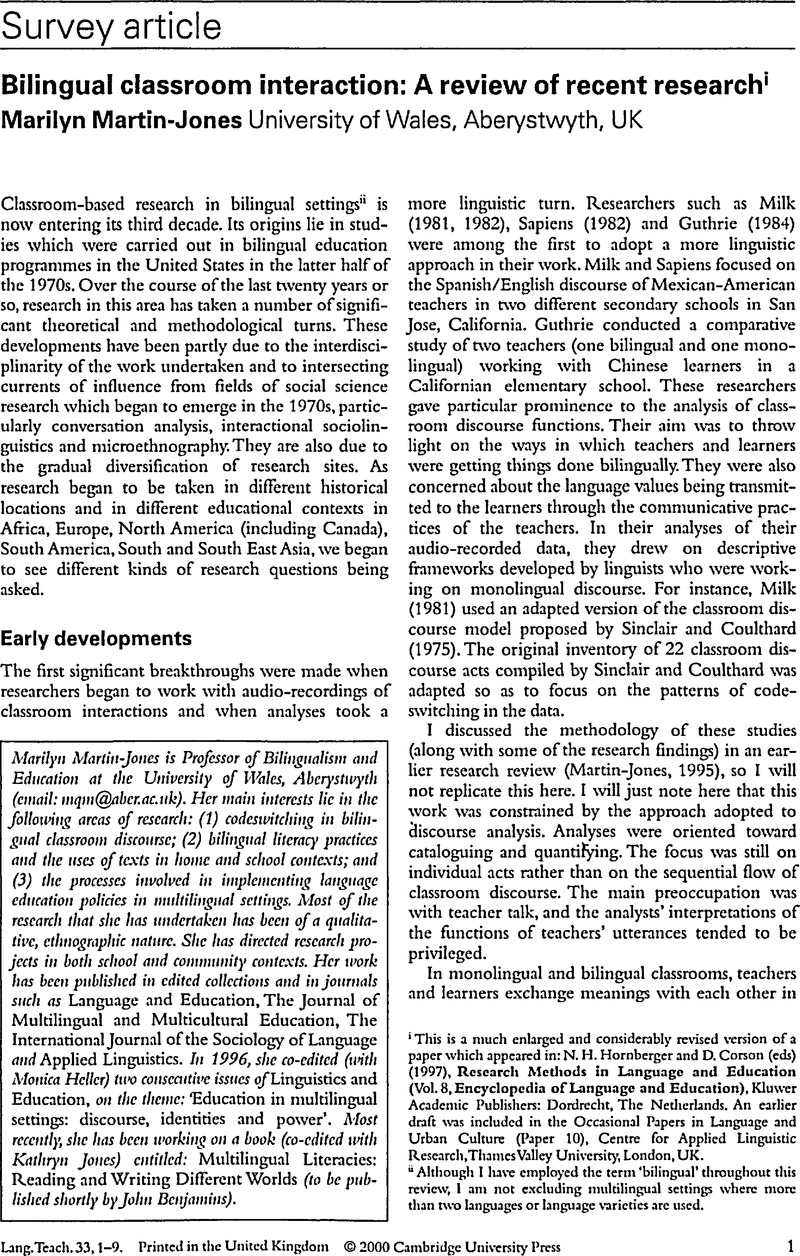Crossref Citations
This article has been cited by the following publications. This list is generated based on data provided by Crossref.
Sunderland, Jane
2000.
Issues of language and gender in second and foreign language education.
Language Teaching,
Vol. 33,
Issue. 4,
p.
203.
Liebscher, Grit
and
Dailey-O'Cain, Jennifer
2004.
Learner Code-Switching in the Content-Based Foreign Language Classroom.
The Canadian Modern Language Review,
Vol. 60,
Issue. 4,
p.
501.
LIEBSCHER, GRIT
and
DAILEY-O'CAIN, JENNIFER
2005.
Learner Code-Switching in the Content-Based Foreign Language Classroom.
The Modern Language Journal,
Vol. 89,
Issue. 2,
p.
234.
Pitsch, Karola
2005.
Interaction, auto-organisation et pratiques d’inscription.
Acquisition et interaction en langue étrangère,
p.
73.
Nikula, Tarja
2005.
English as an object and tool of study in classrooms: Interactional effects and pragmatic implications.
Linguistics and Education,
Vol. 16,
Issue. 1,
p.
27.
Foley, Joseph A
2006.
English as a lingua franca: Singapore.
International Journal of the Sociology of Language,
Vol. 2006,
Issue. 177,
Mickan, Peter
2006.
Socialisation Through Teacher Talk in an Australian Bilingual Class.
International Journal of Bilingual Education and Bilingualism,
Vol. 9,
Issue. 3,
p.
342.
Jones Martin, Marilyn
2007.
Bilingualism: A Social Approach.
p.
161.
Serra, Cecilia
2007.
Assessing CLIL at Primary School: A Longitudinal Study.
International Journal of Bilingual Education and Bilingualism,
Vol. 10,
Issue. 5,
p.
582.
ELLWOOD, CONSTANCE
2008.
Questions of Classroom Identity: What Can Be Learned From Codeswitching in Classroom Peer Group Talk?.
The Modern Language Journal,
Vol. 92,
Issue. 4,
p.
538.
Baker, Colin
2008.
Encyclopedia of Language and Education.
p.
2064.
Lee, Jin Sook
Hill-Bonnet, Laura
and
Gillispie, Jesse
2008.
Learning in Two Languages: Interactional Spaces for Becoming Bilingual Speakers.
International Journal of Bilingual Education and Bilingualism,
Vol. 11,
Issue. 1,
p.
75.
Giraldo, Silvia Valencia
2008.
Encyclopedia of Language and Education.
p.
1008.
Auer, Peter
and
Eastman, Carol M.
2010.
Handbook of Pragmatics.
p.
1.
Avery, Helen
2011.
Lärares språkbruk i tvåspråkiga klassrum.
Educare,
p.
145.
Martin‐Jones, Marilyn
Kroon, Sjaak
and
Kurvers, Jeanne
2011.
Multilingual literacies in the global south: language policy, literacy learning and use.
Compare: A Journal of Comparative and International Education,
Vol. 41,
Issue. 2,
p.
157.
Saxena, Mukul
and
Martin-Jones, Marilyn
2013.
Multilingual resources in classroom interaction: ethnographic and discourse analytic perspectives.
Language and Education,
Vol. 27,
Issue. 4,
p.
285.
Palmer, Deborah
and
Martínez, Ramón Antonio
2013.
Teacher Agency in Bilingual Spaces.
Review of Research in Education,
Vol. 37,
Issue. 1,
p.
269.
Msimanga, Audrey
and
Lelliott, Anthony
2014.
Talking Science in Multilingual Contexts in South Africa: Possibilities and challenges for engagement in learners home languages in high school classrooms.
International Journal of Science Education,
Vol. 36,
Issue. 7,
p.
1159.
Chang, Ya-Ling
2014.
The construction of language value and legitimacy in Aboriginal primary school classrooms in Taiwan.
International Journal of Pedagogies and Learning,
Vol. 9,
Issue. 2,
p.
183.



